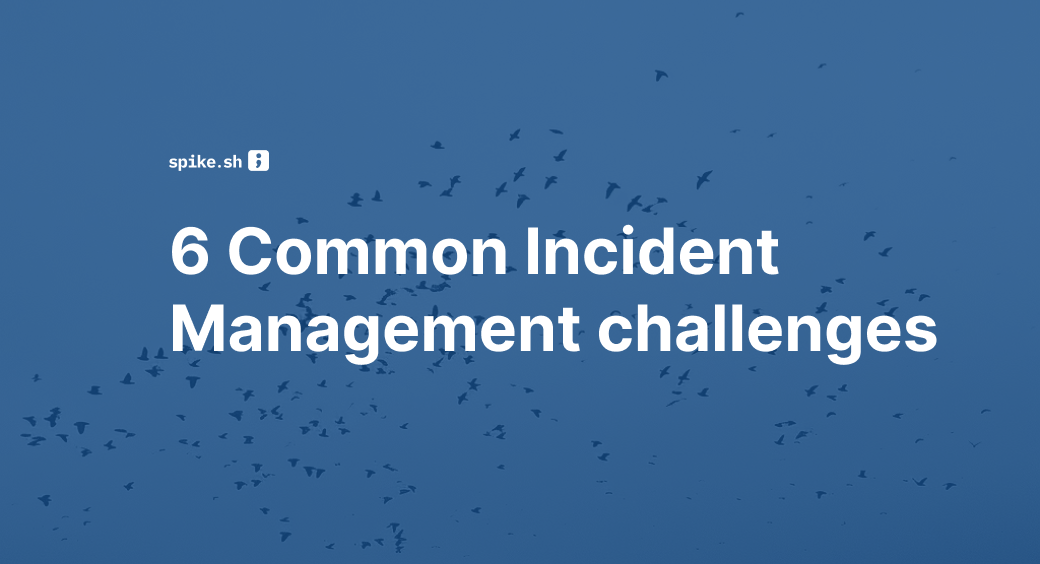$1.81 trillion—that’s how much software operational failures cost US companies in 2022.
But you can avoid such software mishaps. How? With robust incident management!
However, running an incident management is no easy feat. It comes with its fair share of challenges.
The following are some typical problems you might face when managing incidents:
- Poor incident prioritization
- Ineffective alerting and escalation
- Insufficient incident data
- Lack of automation
- Overloaded teams
- Lack of post-incident analysis
Let’s dive into the nitty-gritty of what causes these problems, their consequences, and how to fix them.
1. Poor Incident Prioritization
Which incident has to be resolved first? Answering this question becomes a problem when you don’t have incident prioritization in place.
Incident prioritization is crucial as it defines the gravity and the impact of each incident. This ensures that resources are efficiently directed and incidents are resolved promptly.
However, the absence or mishandling of incident prioritization can result in downplaying critical incidents. The consequences? Downtime, unhappy customers, and negative reviews.
To overcome this challenge, establish clear prioritization guidelines based on impact, urgency, and severity for each incident. Train your responders to assess incidents thoroughly. Keep an eye on your prioritization system and update it as your business evolves.
2. Ineffective Alerting and Escalation
What unfolds when a fire alarm stays silent? A full-blown disaster! That’s pretty much the same when your incident alert system decides to hit snooze on the job.
With vague alerting criteria and inefficient escalation processes, you are at risk of missing critical incidents.
Plus, ineffective escalation can turn your organization into a game of "Who's responsible for resolving this incident?”. This results in a lack of accountability, and nobody wants that!
The fix? Collaborate with your team and redefine the criteria for triggering alerts and escalation paths. Specify who should be in the know at each stage of an incident.
Employ a multi-channel alert system, spanning SMS, Slack, Teams, WhatsApp, and Telegram. For critical incidents, ensure phone alerts are in place.
3. Insufficient Incident Data
Imagine trying to complete a jigsaw puzzle with missing pieces. That’s exactly how it is to deal with incidents when you lack essential data.
Vague incident descriptions make it challenging for stakeholders to grasp what caused an incident and figure out the necessary steps to resolve it.
You can overcome this challenge by setting clear standards for documenting incidents with all the necessary details—what happened, why, and how it was fixed.
Also, encourage your team members to add informative notes, aiding the next individual handling the incident. Implement automation for clear incident messages, route alerts to the right members, and set priority and severity.
If you want to level up your incident descriptions, try Spike’s Title Remapper. It allows you to programmatically modify incident titles in real-time for better context.
4. Lack of Automation
Relying too much on manual incident management is a recipe for increased human error, inefficient workflows, and a real struggle for scalability.
To fix this, start by educating your team about the perks of automation in incident management. Then, dive into your incident management system and identify areas that could benefit from automation.
Here are a few things we recommend you to automate:
- Automate identifying and setting priority and severity of incidents.
- Automate the modification of incident titles to enhance responders' understanding.
- Automate routing of alerts to the right members or escalation policy. Hint: Create a separate escalation for critical incidents and route alerts to it automatically.
- Automate incident resolution by triggering scripts. This way, an incident triggers and resolves itself.
- For low-severity incidents, automate the addition of alerts only when a specific threshold, such as 10 occurrences in the last 24 hours, is met.
With automation, you can create efficient workflows, reduce errors, and take on more incidents without breaking a sweat.
5. Overloaded Teams
Your on-call team is the backbone of your incident management.
But expecting them to be superhuman with lightning-fast responses and constant availability puts them under immense pressure, often leading to burnout.
When your team is fatigued, they’re more likely to make mistakes. More mistakes mean more compilations and downtime. Plus, working in high-stress conditions constantly is a morale killer.
So, to avoid this, establish clear boundaries for on-call duties, support balanced schedules, and encourage breaks and vacations.
Assign varied on-call schedules to different team members to distribute the workload. Consider on-call rotations such as
- On-call during office hours
- On-call after office hours
- On-call during weekends only
- On-call for holidays like Christmas
Also, maintain flexibility by allowing team members to add overrides to cover each other's shifts
At Spike, we are huge proponents of work-life balance and offer three work modes:
- Deep Work: Pause unnecessary notifications to focus on your work at hand. Only receive critical or high-priority incident alerts.
- Cooldown: On-call responders don’t have an easy job. Take a break by offloading your duties to a colleague.
- Out of Office: Going on a vacation or celebrating your kid’s birthday? Take a few days off and pass on your responsibilities to other members with a click of a button.
Furthermore, Spike automatically suppresses and logs repeat incidents. This reduces alert fatigue for your on-call team.
Lack of Post-Incident Analysis
What went wrong? Why did the incident occur? How to prevent it?
Not knowing the answers to these means responders have to spend a ton of time triaging and finding the root cause.
The solution? Include incident postmortems and analysis as a standard step. Postmortems give a deep insight and help learn more about your incidents.
Plus, make sure everyone's on the same page and knows the drill.
Without these practices, knowledge silos occur within the organization. This means certain team members hold vital knowledge that others can't access, creating dependencies and bottlenecks.
Wrap Up
The six challenges we discussed can be real roadblocks, but they are by no means insurmountable. You can tackle these issues head-on and pave the way for smoother incident management.
So, roll up your sleeves, put the resolutions into action, and watch your incident management become more efficient.
It's time to make your incident management rock-solid reliable!
Need any help? Spike’s got your back!
Book a demo here: https://spike.sh/demo

